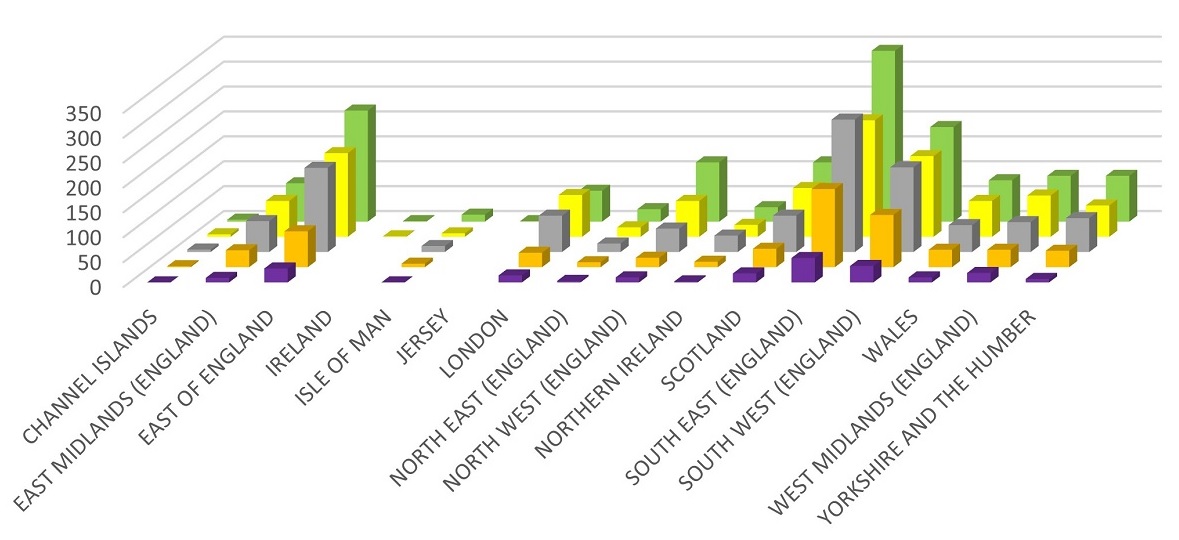Dear beekeepers,
It was a pleasure to meet many of you at the British Beekeeping Show last Saturday! Thanks to those of you who stopped by the National Honey Monitoring Scheme stand and to those who stayed for my talk at the end of the day. The focus of both our exhibit and my talk was on the processing of honey for pollen analysis - explaining why it takes us quite some time to get results from your samples – and people were quite surprised by how complex the workflow is. I recorded the talk, so if you missed it, you can catch up with it on YouTube: Behind-the-Scenes at NHMS.
Getting up to speed
Since the last newsletter, Ellie has been powering through with filtering pollen grains from the honey and has filtered an impressive 873 samples! Between us we have recorded the sugar and water content of 1,017 samples and uploaded these results to the website. Having taken over management of the Scheme when Anna left, I am now up to speed with everything but it still takes a full day to run the DNA extraction protocol on 24 samples.
A bumper year
As we said in December’s newsletter, we received a whopping 1,476 samples this year, which is considerably more than in previous years. Given that 1,943 sampling packs were posted out, this is a remarkably high return rate of 76%! I attended a citizen science conference several years ago and the generally accepted return rate of citizen science projects is ~15%. Thank you for your continued support and enthusiasm for the Scheme.
Fresh from the comb is best
This incredible return of samples does, unfortunately, come with the caveat that the scheme does not have the resources to carry out pollen analysis on every single sample as in previous years. Each honey sample costs ~£110 to process. As a result, we will not be running pollen analysis on extracted honey samples this year because we cannot be certain these samples are from a single hive or timepoint. We apologise for the disappointment this will inevitably cause, but our aim in asking for samples to be collected directly from the super frames was to be sure we are studying a “snapshot in time” for a single hive/location. The reason for this is that the Scheme would like to monitor what bees are feeding on and their potential exposure to pesticides at particular times of year. You can read more about this in a paper we published last year which looks in part at how insecticides affect bee diseases: Nature article. For this we need honey collected directly from freshly capped cells on the comb that represent nectar collected in the last few weeks, rather than extracted honey.
We are still aiming to run the pollen analysis on an impressive 1,152 samples but, as you may know from previous years, there is ~15% failure rate in DNA extractions from pollen and/or amplifying the DNA barcode from those extractions. We are therefore expecting to return results for ~1,000 of the samples sent in.
All samples will still have the sugar/water content measured and uploaded to the website, along with the habitat data surrounding the hive. They will also all be kept in our honey archive for future research.
Doing our best for you with limited resources
We are trying our best to meet huge demand with our limited resources. To avoid disappointment in future, we have taken the difficult decision to limit the number of sample packs we send out in 2023 to around 1,200. We are keen to give preference to beekeepers with hives in areas from which we have received fewer samples in previous years, as shown in the bar chart below. If you would like to send in samples this year please request a sample pack on the website, as per usual, and I will email you if we will not be sending you a sample pack because your area is already well-represented.

We will continue to analyse as many of your honey samples as our resources allow. We would like to stress our gratitude for your participation in the Scheme and hope you will continue to support us and follow its progress even if your samples are not analysed for pollen this year. With your support we have made significant progress in understanding what bees feed on and the pesticides they are exposed to. This information is informing new land management policies to improve the environment. Looking to the future, we hope to use the Scheme to increase our knowledge of bee diseases, how they are transmitted and how they can be better controlled.
Best wishes,
Jenny
UKCEH National Honey Monitoring Scheme
